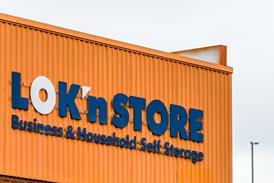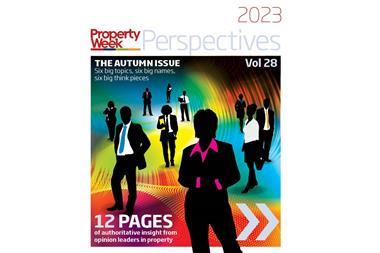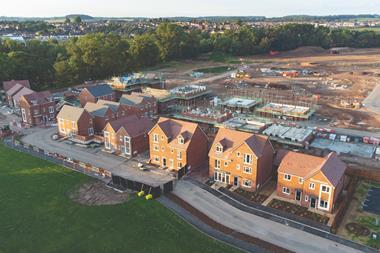There is much discussion about big data across many sectors, not just property, but what use is all this data - generated from building information modelling, the internet of things and numerous other methods - without clarity on how it should be put to work?

Residential property managers have relied primarily on their experience for how a building should be run and maintained.
Combine this with a clear understanding of the information generated from running that building and you have a powerful combination. But for what purpose?
Using the significant data and insight amassed over the past 40 years, we are honing a methodology that combines instinct with information and puts the wellness of our customers first. Big data and proptech are the buzzwords, but unless hard facts are united with human insights, will property managers really be making the best decisions for residents’ wellbeing?
With the largest data set in the industry, we understand both the buildings we manage and our customers’ needs and expectations.
Get involved - The Power of Proptech 2018: get your views heard
The ability to analyse and apply that data has made our residential management more efficient and our developments positive places to live. Combining our experience with our data gives our residents, as well as our developer and investor clients, the best service and experience.
Data and wellness
Wellness has been climbing the property development agenda for the past few years. In the workplace, employers are already demanding buildings and facilities that improve the health and mental wellbeing of their staff, while minimising their impact on the environment.
The need for happy people, greater stability, lower turnover and reduced costs are the principles that have been slowly filtering through to the residential sector. But homing in on the most effective ways to manage properties so that residents are happy, safe and secure is only truly leveraged when experience is aligned with significant data and insight. While this approach may be common in the commercial sector, it is still a relatively new concept to collect and analyse this kind of data in the residential world – but not for us.
How does wellness translate into the home? It is a feeling of being safe, knowing the building is secure, that the lifts and gates are reliable, and the building is warm or cool when it needs to be. It’s about having well-managed and maintained gardens, clean and tidy areas for residents, features that reduce the stress of busy lives and the effective maintenance and management of those features.
These features are higher on residential investors’ and developers’ list of requirements than ever. Such factors not only have an impact on people’s decisions on where they choose to live, but also how long they choose to stay. More and more we are being asked to not just run a property for a client, but also to advise on the design of the property at an early stage, because we can help guide the process by drawing on our extensive data and insight.
Practical application
Our data is of course informative, both at a development level and comparatively across our portfolio of more than 3,900 developments. But it is the collective expertise within FirstPort that allows us to draw insights and understand how to apply it to effectively manage our customers’ homes and our clients’ assets.
That’s why we see it as essential to involve all our employees in the data journey. By bringing together the data we hold on our portfolio, its operations, health and safety, estate finances and so on, we possess powerful predictive models to help us deliver excellent residential property management.

Understanding likely points of failure or risk in any building or facility helps to better predict future costs for our customers and deliver a more reliable return for our clients.
One of the ways we put this into practice is through our “four pillars” key performance indicators, a framework based on the four most important areas of a well-managed residential property scheme. Take health and safety, for example. The health and safety data we collect identifies which buildings are succeeding or falling short in a given area and indicates why. This allows us to proactively respond to issues before they’re ever raised by residents.
When it comes to healthy estate finances, effective procurement is an essential component. We are using data and insight to make our procurement more efficient. This means we can predict the demands of our portfolio by individual development, regionally and nationwide, as well as tracking the quality of contractors’ service.
Putting people first
The wellness of the people who live in our buildings is of obvious importance: happy tenants stay for longer because they are satisfied, they tell their friends, and word spreads.
We’ve created a portal for our residents that can be used on their tablets and phones to help provide a positive customer experience, managing everyday building maintenance without fuss. This portal allows us to address issues such as maintenance requirements, as and when they arise, as speedily as possible and to gather significant insights to aid future predictive analytics.
But we think data shouldn’t just be used to fix and predict problems. We are trialling smart technology in a number of developments that is collecting and utilising data to improve building efficiency. These trials are an exciting step, creating additional value for our residents.
It is also important to use data to have a positive impact on the wellness of our own teams. For instance, we can look at how bad weather has affected resourcing in the past, the impact it has had on the volumes of calls from residents and how quickly and effectively we were able to respond to those calls.
Bad weather generates more customer enquiries and we therefore require more people in the contact centre. If the contact centre is under-resourced, it’s not just the customer who suffers but also our own team, so using predictive insights enables us to strike the right balance.
Looking to the future
We are working to ensure our data is understood and applied intelligently. Via our management information system, MySight, FirstPort employees have access to data and they are trained to interpret and apply it to improve performance in their areas of responsibility.
Data is a powerful tool in property management and we make it part of our practice and working culture, because people are still the key to excellence. Our approach to humanising and using data intelligently on our diverse and large portfolio enables us to care for our customers better and enhance their experience. There aren’t many companies that can do that and we are proud to be leading the way in the professionalisation of residential property management.
Martin King is director of business development, marketing and communication and Tom Hine is head of transformation and innovation at FirstPort
About FirstPort
With 40 years’ experience, FirstPort is the largest residential property management company in the UK. It manages more than 184,000 homes in England, Wales and Scotland across more than 3,900 developments and has more than 3,000 employees dedicated to looking after people’s homes.
Topics
PW Perspectives: wellness and sustainability climbing the agenda
- 1
- 2
 Currently reading
Currently readingHumanising big data is the key for property managers
- 3
- 4
- 5
- 6




































No comments yet